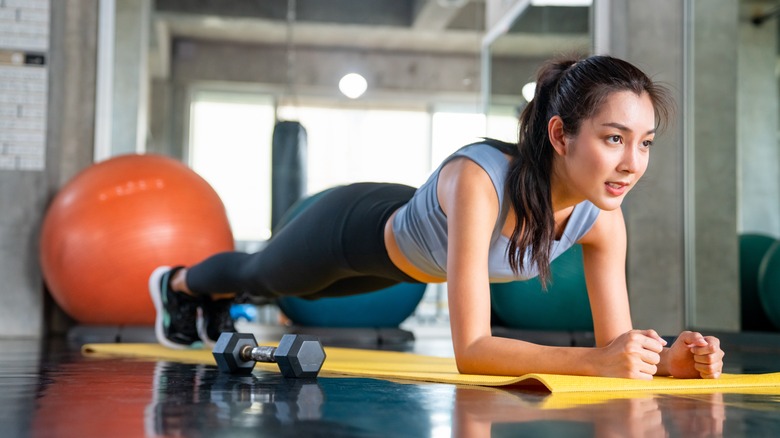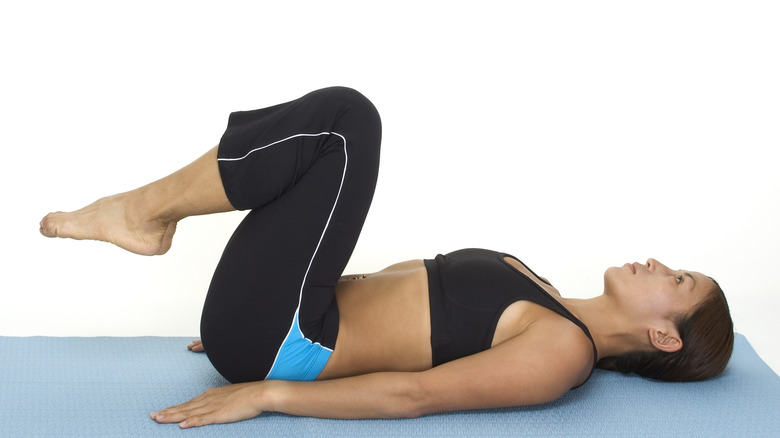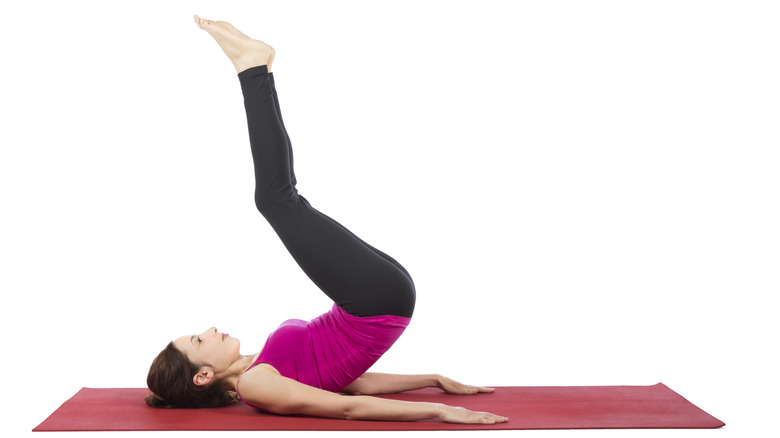Ab Workouts To Try If You Have A Bad Neck
Having a strong core can give you more stability and balance for running, sports activities, and everyday activities, Mayo Clinic explains. Crunches and sit-ups are common exercises that can strengthen the abs and other core muscles. While these moves have been proven to be effective in building abdominal muscles, (via Women's Health) they can also strain the neck, or make an already-strained neck worse.
You probably learned how to do these exercises when you were in elementary school and watched many of your classmates perform them incorrectly. Or, maybe you were one of the ones doing them wrong. But even for adults, it's actually common to have bad form when doing certain abdominal workouts, which can lead to or worsen neck pain. Ironically, "core strength is key in preventing neck pain," according to Harvard Health Publishing, but sometimes the steps toward attaining that strength can cause neck pain.
Does that mean you're limited to the seated ab machines at the gym if you want a good ab workout without neck pain? Not necessarily. There are actually several ab workouts you can try if you have neck pain or want to prevent it.
The benefits of planks
Planks are considered by many to be one of the best core workouts because of how they work the muscles and because they're safer than other ab exercises, as the American Council on Exercise (ACE) explains. According to LIVESTRONG.com, they won't put a strain on the neck if they're done correctly and with good form. That's because, unlike sit-ups and crunches, planks don't require any movement of the head or neck to engage the ab muscles.
To do a plank, get into a push-up position, and place your body parallel to the floor so that it's in a straight line. You can either rest on your palms (high plank) or forearms (low plank). To ensure a neutral spine, avoid lifting your head too much. It may help to aim to look at the floor. Tighten your core to prevent your back from arching or sagging.
Dr. Glenn Wright, a professor of exercise and sport science at the University of Wisconsin, La Crosse, shared his thoughts with ACE on planking. "They maintain the stability of the core muscles, which support proper posture by safeguarding an erect position and proper alignment of the spine," he said.
Bent-knee reverse crunches are one of the easier ab workouts
The bent-knee reverse crunch is arguably one of the easiest ab workouts to perform. LIVESTRONG.com describes it as "a good starter abdominal exercise for someone with a neck injury ... because it doesn't require any upper body work other than core contraction to stabilize the body."
As the name implies, this type of crunch involves bending your knees and pulling your legs upward, as opposed to lifting your torso upward like you would with a traditional crunch. Origym Personal Trainer Courses provides a step-by-step guide and video tutorial of the exercise.
While lying on your back with your arms at your sides, tighten your abs. Then, slowly bring your knees toward your shoulders. Depending on the length of your torso and legs, and your range of motion, your legs might touch your chest or rest a few inches above it. Next, slowly bring your feet back down to the ground and straighten your legs a bit until your heels are about an inch off the floor. Your knees should be slightly bent the entire time.
According to Bodybuilding.com, this crunch "targets the lower portion of the rectus abdominis." These are the muscles that many refer to as "sick-pack" muscles. And in addition to strengthening the core, it can strengthen the hip flexors.
Reverse crunch is another effective ab workout
If you want to activate more of the upper abdominal muscles than the bent-knee reverse crunch does, you can try a standard reverse crunch, also known as a leg lift with hip raise. Chron claims this exercise activates the "six-pack" muscles, obliques, hip flexors, quadriceps, and adductors. Verywell Fit considers this another beginner ab workout. It's similar to the bent-knee reverse crunch in that you have to lie on your back to do it, so it's safe to do if you have neck pain. It just involves one additional step.
While lying on your back, place your hands under your butt and lift your legs up toward the ceiling, keeping the knees bent slightly, as LivestrongWoman demonstrates. When your thighs are at a 90-degree angle, raise your hips toward the ceiling. This move should lift your butt off the ground a few inches. Then, drop your hips back to the ground, followed by your legs, and repeat. Be sure to keep your heels off the ground the entire time to keep the core engaged.
Having neck pain doesn't mean you can't do ab workouts from home. Planks, bent-knee reverse crunches, and reverse crunches are among the many ab exercises you can perform that are safe for bad necks. Just be sure to face the ground during those planks to ensure a straight spine, and keep the core engaged throughout all the exercises to get the best results.



